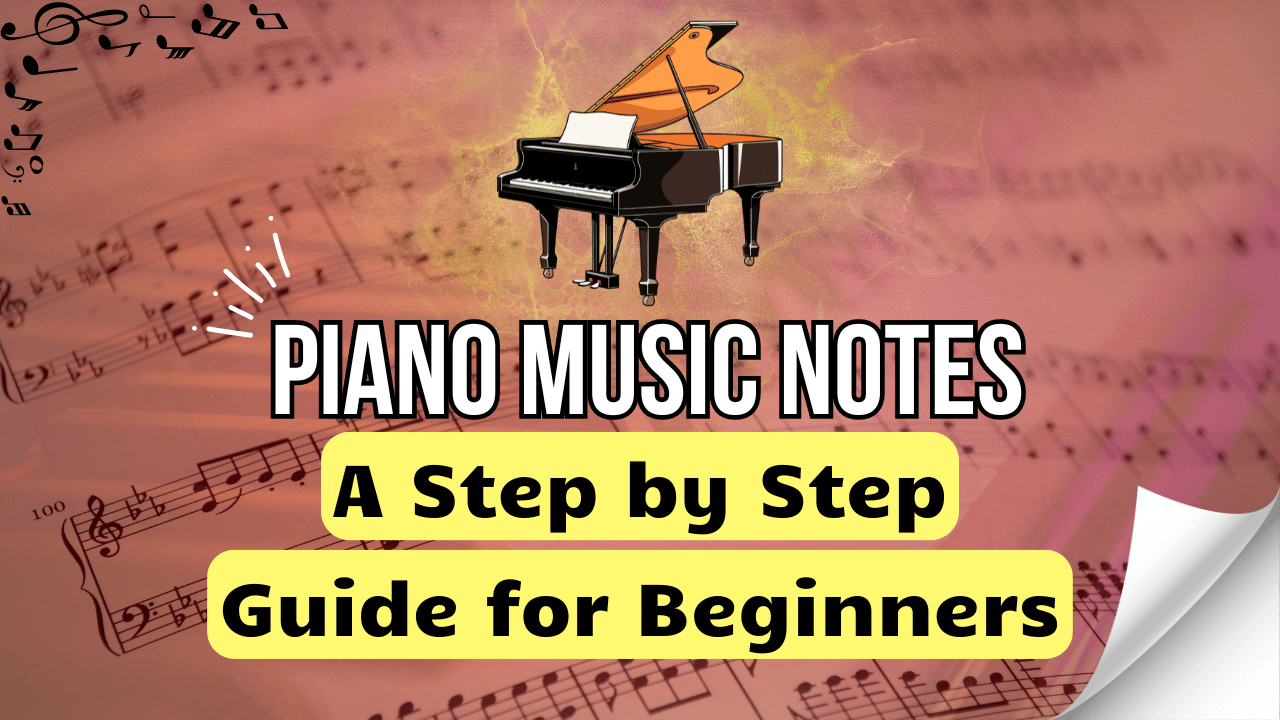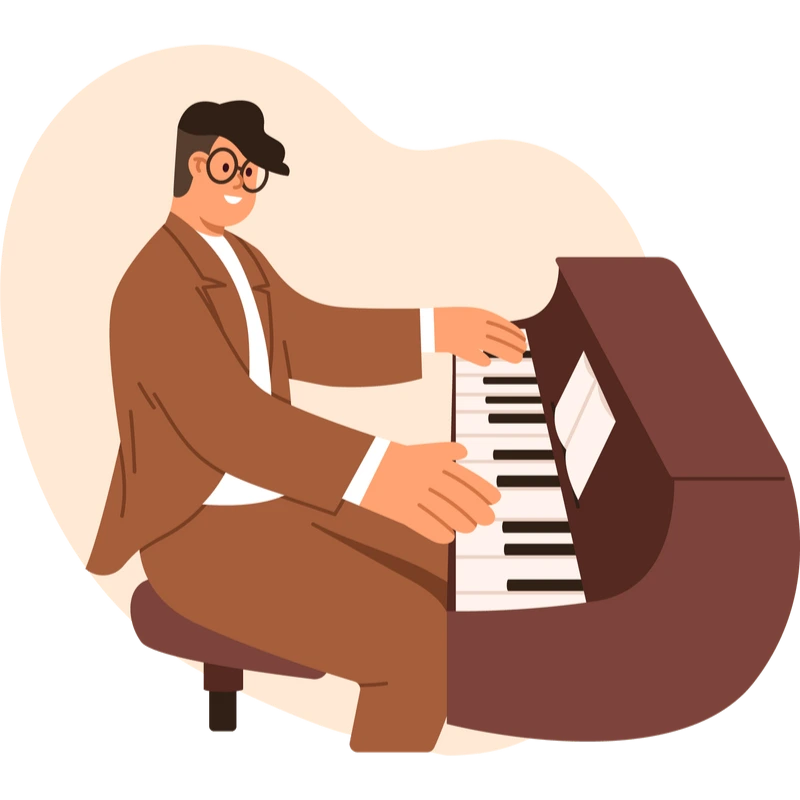- Understanding the Staff
- Key Points:
- Clefs: Treble and Bass
- Learning the Piano Notes
- Treble Clef Line Piano Notes:
- Treble Clef Space Piano Notes:
- Bass Clef Line Piano Notes:
- Bass Clef Space Piano Notes:
- Understanding Music Note Values
- Time Signatures
- Key Signatures
- Rhythm and Counting
- Ledger Lines
- Practice Techniques
- Connecting Notes to Piano Keys
- Common Mistakes to Avoid
- Building a Practice Routine
- Conclusion
Learning to read piano notes is like unlocking a new language—a language that helps you understand and play your favorite songs. Whether you’re a complete beginner or have some experience, understanding music notes is an essential skill that will elevate your piano playing. At first glance, the piano sheet music might look overwhelming with its lines, symbols, and dots. But, once you grasp the basics, it all starts to make sense! The piano notes on the page tell you which keys to press on the piano, how long to hold them, and how loud or soft to play.
Understanding the Staff
Getting to know the staff is the first step in playing the piano by reading the music. The staff is made up of five horizontal lines and the four spaces between them. Each line and each space represent a different musical note.
Key Points:
- The staff is the book on which music is written.
- Notes are written on lines and in spaces.
- The symbol of a note on the staff means a higher pitch of the sound.
Clefs: Treble and Bass
The two clefs mostly in piano notes are treble clef for higher notes and bass clef for lower ones.
- Treble Clef (G Clef)
- Actually it is a symbol of “G” in a fancy font
- Is used for the right hand
- Is used for representing higher notes
- Bass Clef (F Clef)
- Looks like a backward “C” with two dots
- It is a complement to the treble clef and is for the left hand
- The bass clef is for lower notes.
Learning the Piano Notes
As of right now let us go deeper into the piano notes on the clefs. First we will check out the treble clef.
Treble Clef Line Piano Notes:
- E – First line
- G – Second line
- B – Third line
- D – Fourth line
- F – Fifth line

Treble Clef Space Piano Notes:
- F – First space
- A – Second space
- C – Third space
- E – Fourth space

A way to make the mnemonic about the lines simpler is “Every Good Boy Does Fine” (E, G, B, D, F). As for the spaces, just teach them the word “FACE” and they will remember the notes.
Bass Clef Line Piano Notes:
- G – First line
- B – Second line
- D – Third line
- F – Fourth line
- A – Fifth line

Bass Clef Space Piano Notes:
- A – First space
- C – Second space
- E – Third space
- G – Fourth space

The bass clef lines have a memory aid “Good Boys Do Fine Always” (G, B, D, F, A). The spaces are formed by the word “All Cows Eat Grass” (A, C, E, G).
Understanding Music Note Values
The music notes have different lengths of time that they are played. The length is shown by the appearance of the note. A whole note is written like a full circle (4 beats)
- W (Whole Note): A note is as a round white head and has no stem and lasts for four beats
- H (Half Note): A note has a round white head, a stem and it lasts for two beats
- QN (Quarter Note): A note has a round head that is half-filled, a stem, and it lasts for one beat
- EN (Eighth Note): This note is a round head that is half-filled, has a stem, and one flag, it lasts for half a beat
- SN (Sixteenth Note): This note is a round head that is half-filled, has a stem, and two flags, it lasts for a quarter of a beat
Time Signatures
Time signatures disclose to you the number of beats the measures have and the kind of note that is counted as one beat. The most common time signature is 4/4, also known as “common time.”
Understanding 4/4 Time:
- Top number (4): Four beats per measure
- Bottom number (4): A quarter note gets only one beat
Key Signatures
The Key signatures in music are the sets of accidentals following the clef that notify the player about the notes that are sharp or flat and that should be played throughout the piece.
Remember:
- Sharps (#) are used to raise the tone a half step
- Flats (♭) are responsible for lowering the tone a half step
Dynamics and Expression Marks
The symbols of dynamic and expressive values define the volume of the sound:
| SYMBOL | NAME | MEANING |
| pp | pianissimo | very soft |
| p | piano | soft |
| mp | mezzo-piano | moderately soft |
| mf | mezzo-forte | moderately loud |
| f | forte | loud |
| ff | fortissimo | very loud |
Rhythm and Counting
Having a firm grip on rhythm is a major factor that influences music reading. Begin by counting the beats out loud while you are clapping or tapping the rhythm. Start off with easy rhythms and gradually increase the complexity.
Ledger Lines
Ledger lines are those little horizontal lines that you see above or below the staff to represent the extra piano notes outside of the standard number, five lines, and four spaces.
Accidentals
Accidentals are symbols that change the pitch of notes in a musical piece:
- Sharp (#): Raises the pitch by a half step
- Flat (♭): Lowers the pitch by a half step
- Natural (♮): Cancels a sharp or flat already there
Chords
Chords are multiple notes played at one time. Start off by practicing the basic 2-note chords (intervals) and then move to the 3-note chords (triads).
Practice Techniques
To build up your note-reading skills:
- Use flashcards to memorize note positions
- Play sight-reading exercises daily
- Take advantage of educational apps and websites that offer interactive and engaging instruction
- Share the part of the music with the other player if the timing and accurateness weren’t good in your turning and you will all get together
Connecting Notes to Piano Keys
Once you get a hold of the notes of each key, it becomes a lot easier for you to read the musical notes. Here are some pointers for you to remember:
- C is typically the middle name that you use
- White keys are the names of the natural notes like (A, B, C, D, E, F, G)
- Black keys are both sharps and flats
Common Mistakes to Avoid
For the beginners who are new to music notes, here are some of the common mistakes you should be careful not to do:
- Not learning how to place their hands correctly
- Not counting correctly.
- Paying too much attention to individual notes but not recognizing the patterns
- Skipping theory and practicing only through playing difficult melodies.
Building a Practice Routine
The main way of improving the musician’s music reading is through practicing. Here are some steps that you can follow to improve your reading practice:
- Set a specific time every day for practice
- Begin with short exercises (15-30 minutes) and then build up to longer ones
- One concept at a time investment.
- Every once in a while go over the material you have learned over again to make sure you still remember it.
Conclusion
Learning to read piano music notes opens up a world of possibilities for any aspiring pianist. While it may seem challenging at first, with practice, recognizing notes and understanding piano sheet music becomes second nature. It’s the key to playing a variety of songs and styles, from classical to pop. As you continue to practice, you’ll find that reading music enhances your musicality, allowing you to interpret pieces more accurately and play with confidence. Remember, like any skill, reading piano notes improves over time—so be patient with yourself and enjoy the journey!































